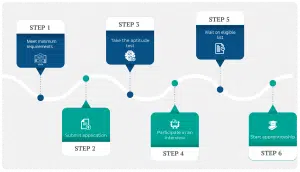The Optometry Admission Test, better known as the OAT, is a screening test administered by optometry schools to test your knowledge in physics and natural sciences, your reading comprehension abilities, and your quantitative reasoning skills.
The test is just part of the application process, and doing well on the test won’t guarantee a place in the optometry school of your choice. However, schools do put a lot of weight on your OAT scores, so if you are planning on a career in optometry, you’re going to need to work very hard to do well on this test.
The test is taken at a testing center on a computer, and costs $490, although fee waivers are possible in the event of financial hardship. You’ll have about four hours and five minutes (plus a break) to answer 230 multiple-choice questions.
Did you know?
The OAT has 230 questions, covering 6 subjects in four different sections. You will be tested on (1) biology, (2) general chemistry, (3) organic chemistry, (4) physics, (5) reading comprehension, and (6) quantitative reasoning.
Every school sets its own standards for students, and the grading is standardized, allowing schools to compare applicants who took the test at different times.
To excel on this test, you will need to have a strong understanding of the material and work quickly to complete the test on time.
OAT Question Types Explained
The OAT is a multiple-choice test. It covers six subjects and is divided into four sections. You will have four hours and five minutes to complete the test. In addition, there is an optional 15-minute tutorial before the test begins, a 30-minute break after the reading comprehension section, and an optional post-test survey that takes 15 minutes to complete.
| Section | Number of Questions | Time Limit | Average Time Per Question |
|---|---|---|---|
| Natural Sciences | 100 | 90 minutes | 54 seconds |
| Reading Comprehension | 50 | 60 minutes | 72 seconds |
| Physics | 40 | 50 minutes | 75 seconds |
| Quantitative Reasoning | 40 | 45 minutes | 67.5 seconds |
Natural Sciences
The natural sciences portion of the exam tests your knowledge of biology, general chemistry, and organic chemistry. You will have 90 minutes to answer 40 biology questions, 30 general chemistry questions, and 30 organic chemistry questions.
All questions are multiple-choice, giving you five options to choose from. Choose carefully, as some questions have “None of the Above” or “All of the Above” as an option.
- Biology – spend time preparing for questions on cell and molecular biology, diversity of life, structure and function of the systems, developmental biology, genetics, evolution, ecology, and behavior
- General Chemistry – be prepared for questions covering stoichiometry and general concepts, gases, liquids and solids, solutions, acids and bases, chemical equilibria, thermodynamics and thermochemistry, chemical kinetics, oxidation-reduction reactions, atomic and molecular structure, periodic properties, nuclear reactions, and laboratory skills.
- Organic Chemistry – focus your studying on mechanisms, chemical and physical properties of molecules, stereochemistry, nomenclature, individual reactions of the major functional groups, and combinations of reactions to synthesize compounds, acid-base chemistry, aromatics, and bonding.
Winning Tip
With so many questions in the section and not a lot of time, you’ll want to move quickly, answering the questions you know and then coming back for the questions that were out of your comfort zone.
Reading Comprehension
You have an hour to read the passages and answer the 50 questions. The reading comprehension portion of the test contains three passages covering scientific topics. While you don’t need to have any preexisting knowledge on the topics covered in the passages, the multiple-choice questions will test your ability to read, comprehend, and thoroughly analyze basic scientific information.
Winning Tip
Give yourself 20 minutes per passage, and start with the easiest one first. On average, you’ll want to give yourself about 8-9 minutes to read the passages, allowing yourself 11-12 minutes to read through and answer the questions.
Note: After completing the Reading Comprehension section, you have the option to take a 30-minute break. Take advantage of the time to give yourself a break. Physics is coming up next.
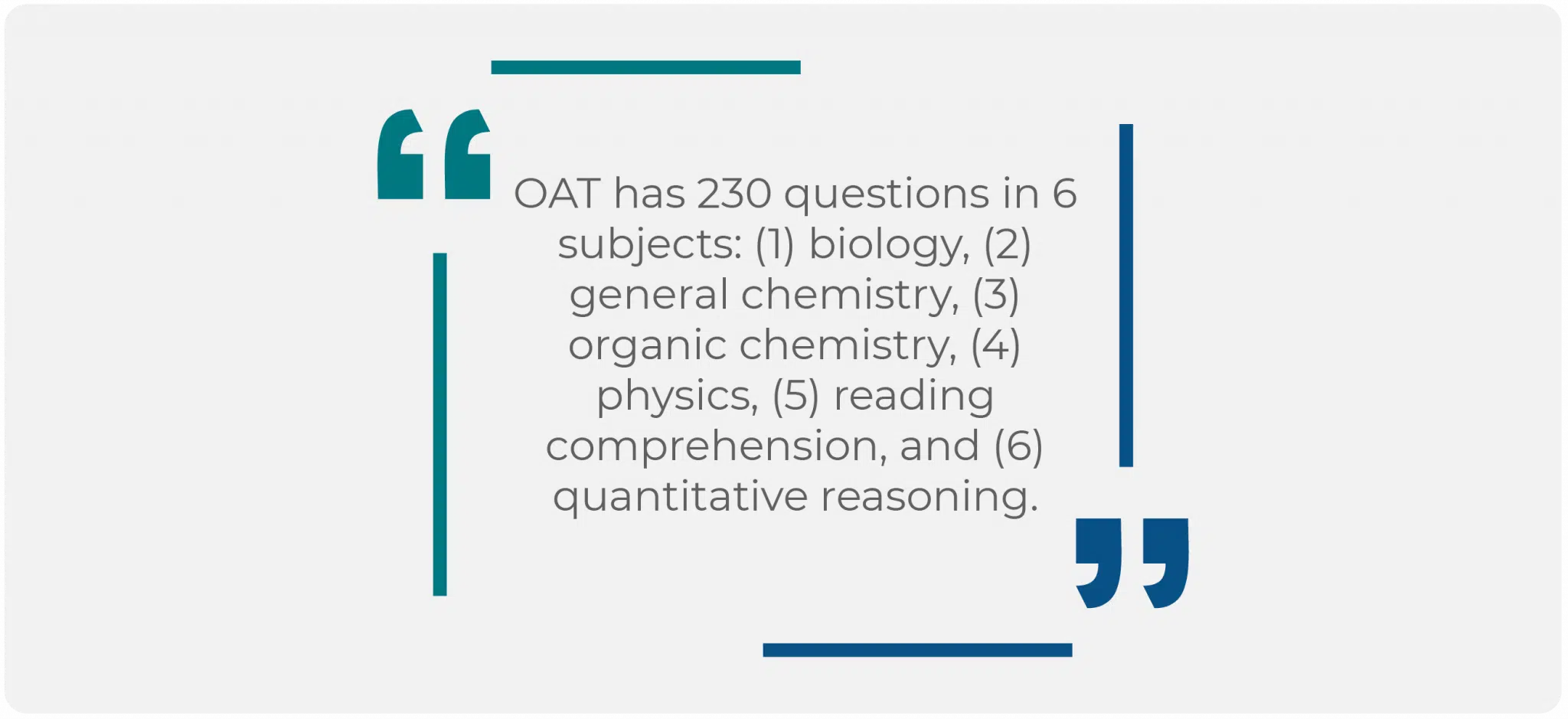
Physics
You’ll have just 50 minutes to answer 40 multiple-choice physics questions. The topics covered are units and vectors, linear kinematics, statics, dynamics, rotational motion, energy and momentum, simple harmonic motion, waves, fluid statics, thermal energy and thermodynamics, electrostatics, D.C. circuits, and optics.
Winning Tip
Know your strengths, and try to answer those questions first before going back to the beginning of the test and answering the questions you are less familiar with. Remember, you only have 75 seconds per question, so don’t spend three minutes trying to work out the answer.
Quantitative Reasoning
You’ll have 45 minutes to answer 40 math questions in this section. There are two types of questions that you’ll be facing.
- Mathematical problems – study algebra, data analysis, interpretation, sufficiency, quantitative comparison, probability, and statistics
- Applied Mathematics – word problems
While you are not allowed to bring a calculator into the test, there will be a calculator available on the screen for you to use.
Winning Tip
To save time, you don’t always need to work a problem through until the end. You can frequently eliminate answers that are obviously wrong and use estimations to answer the question quickly.
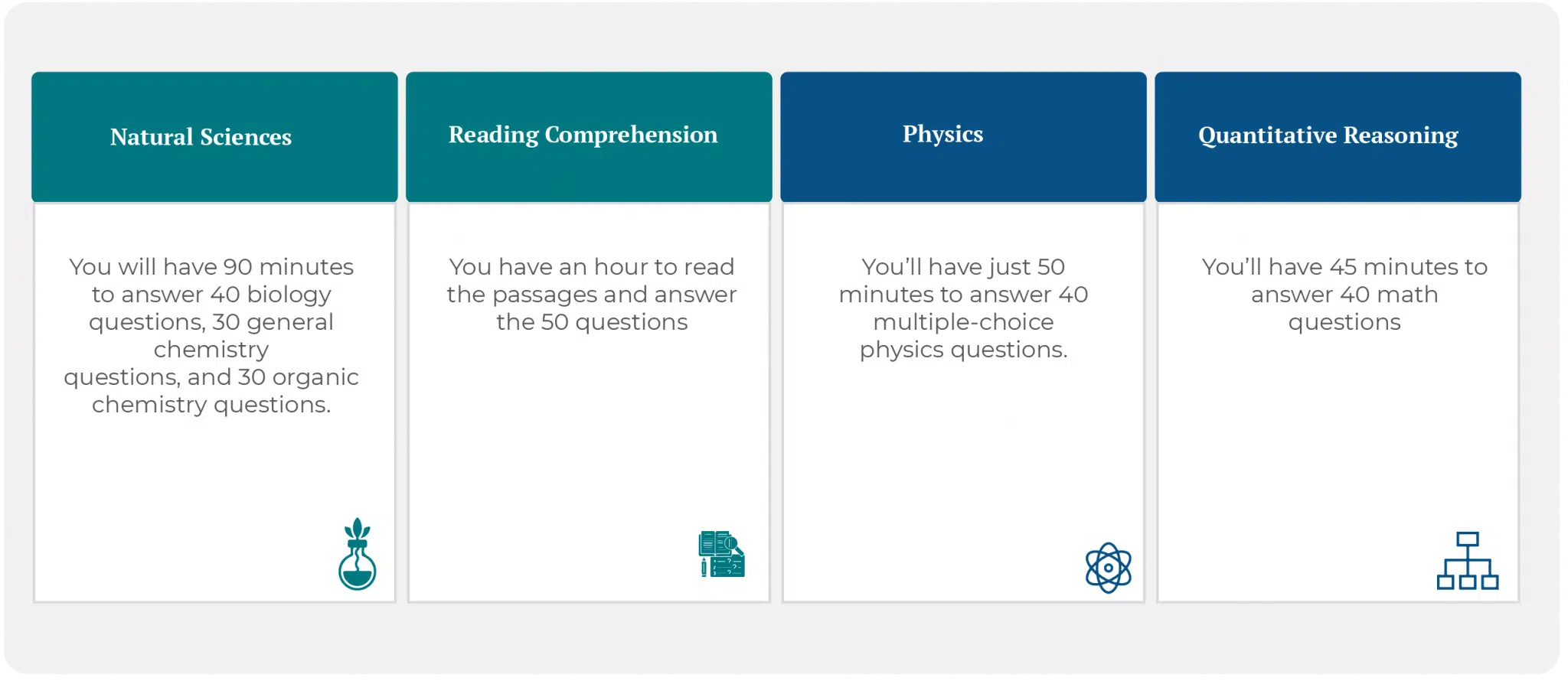
OAT Preparation Strategies
If you are serious about going to optometry school, you must prepare for the OAT. The ADA, which administers the test, recommends that applicants use textbooks and lecture notes as primary sources. They also recommend taking practice tests, reviewing reference texts, and taking an OAT tutorial.
Many candidates for optometry school plan to take the test in the summer between their junior and senior years. If possible, take a lighter course load that semester to give yourself more time to study. However, before taking the test you should have already taken most of your optometry school prerequisites so you already have a basic understanding of biology, chemistry, and physics.
You’ll want to create a dedicated study schedule for the test, which is about 2-3 months long. It’s also a good idea to choose a date and register for your test early. Creating a deadline will help motivate you to study and keep you on track.
In addition, here are some other things you can do to prepare for the OAT.
1. Find an OAT Test Prep Course that Meets Your Needs
You want a comprehensive test prep course that is focused on the OAT, rather than signing up for generic physics and science classes. When looking for the right course, here are some things to keep in mind:
- Find a course that works for you. If you prefer video lessons or text-based lessons, look for the course that will play to your strengths.
- Don’t sign up for any generic optometry course. Find an OAT course, which will cover the material you can expect to see on test day.
- Look at user reviews. Before spending money on a course, make sure that it has helped others in your position.
- Find recommended textbooks published by authors that you like.
2. Identify your Strengths and Weaknesses
Use practice tests to see which areas you need to focus on. This will help guide your studies, making your study time more efficient. For example, if you did well in physics but struggled on the organic chemistry portion of the test, you’ll want to put more effort into studying organic chemistry.
Once you’ve identified your strengths and weaknesses, build an action plan to help build up your weaknesses. Create measurable goals so you can see progress as your studying continues.
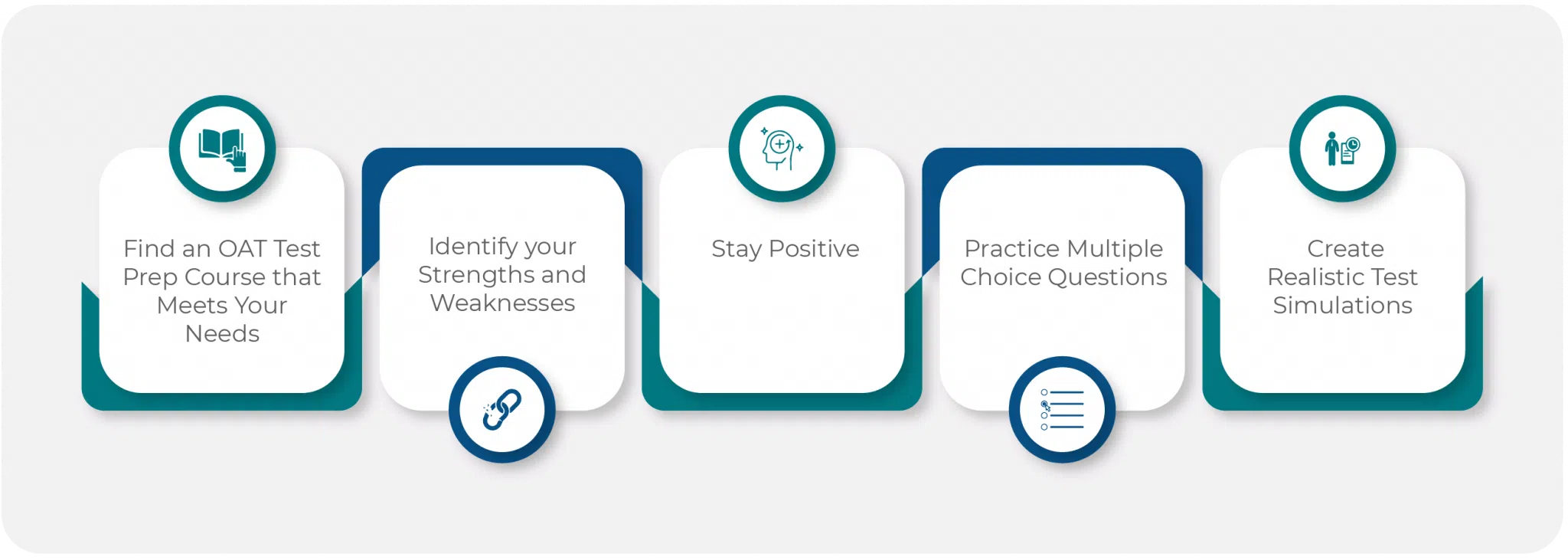
3. Stay Positive
Over the course of studying, you may find yourself struggling with one particular area. Work with a colleague to try and identify the root causes of your mistakes, so you correct them and improve before the test.
4. Practice Multiple Choice Questions
This might seem silly, but answering multiple-choice questions quickly and correctly is a skill set. As the entire OAT is a multiple-choice test, this can’t be overstated.
You’ll need to learn how to quickly eliminate options, and make educated guesses. Find a course that teaches these skills.
Be sure to check out iPrep’s tutorials; we include techniques like these in our online courses.
5. Create Realistic Test Simulations
The more realistic the experience, the more comfortable you will be when you actually take the test. Practice tests should be taken on a computer, using the same time constraints, without access to notes or a calculator to prepare yourself for the test-day experience.
iPREP: Concise. Focused. What you need.
Sign up
Immediate access
Practice
Online self-paced
Pass
Ace that Test!
Test Features
The Optometry Admission Test experience is consistent, regardless of the state you take it in or the school you are applying to. However, different schools require different scores for the candidates.
Test Fast Facts (tl;dr)
- Total of 230 questions
- The test takes four hours and five minutes to complete
- There is an optional 15-minute pre-test tutorial
- There is an optional 30-minute break
- There is an optional 15-minute survey after completing the test
- There are four sections, covering six categories
- Natural sciences (biology, general chemistry, organic chemistry)
- Reading comprehension
- Physics
- Quantitative reasoning
- Calculators may not be brought into the test. There is a built-in calculator that can be used during some sections of the test
- A perfect score is 400. A score of 340 or higher is considered excellent
- OAT is administered at Prometric test centers
- OAT is presented in the English language
- Test-takers must bring two current forms of ID: one with a picture such as a driver’s license and one with a signature, such as a credit card
- The name on the ID must match the application exactly
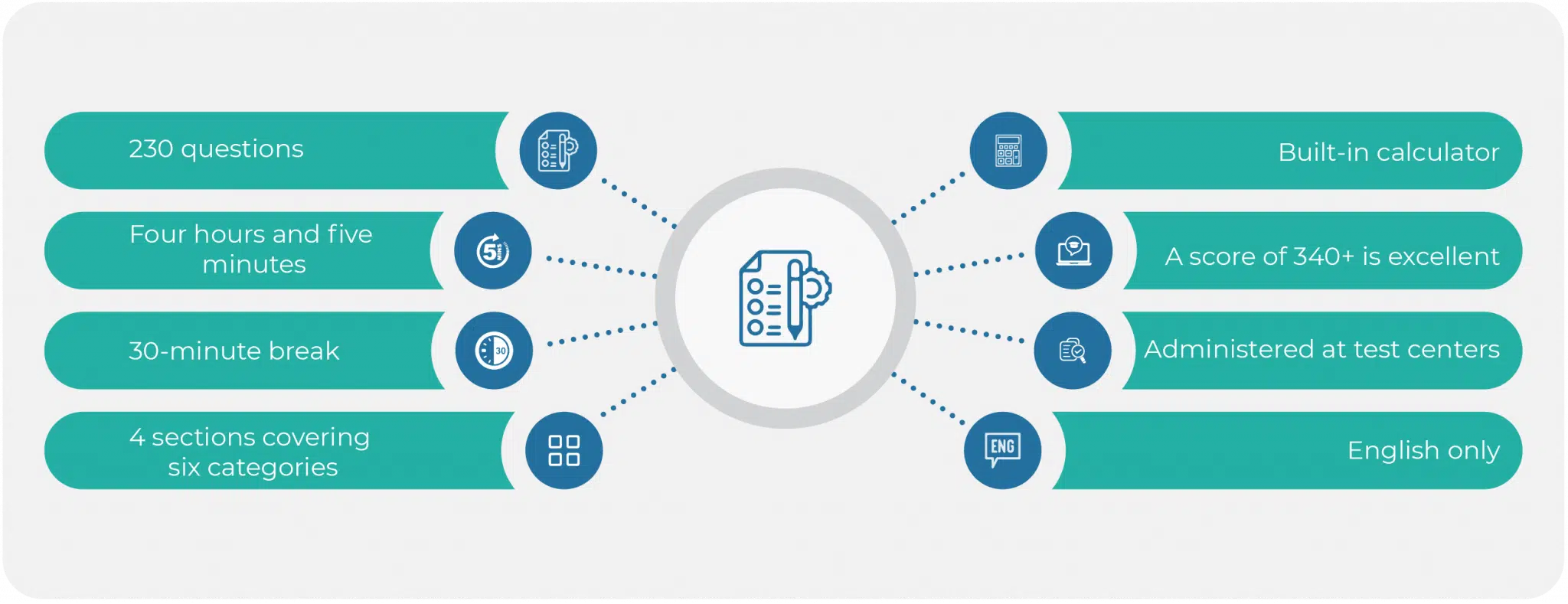
Retake Policies
After failing a test, candidates can retake the test after 90 days. Additional retakes can only be taken after a 12-month period. If you need to retake the test, you will need to pay the full fee. Some optometry schools may have different policies.
Fees
OAT fees cost $490. They are non-refundable and non-transferable. There are additional fees as well for optional items and rescheduling tests.
| Fee Type | Amount |
|---|---|
| Score Report – Optional | $45 per report |
| Score Audit | $65 |
| 45-day Eligibility Extension Fee | $125 |
| Reschedule Fee – 30 days or more before test | $25 |
| Reschedule Fee – 5-29 days before test | $60 |
| Reschedule Fee – 1-4 days or more before test | $150 |
Results Scale and Interpretations
Each section of the OAT yields a raw score, which is the sum of your correct answers. The raw score is then converted into a scale score, ranging from 200-400. The scale score allows optometry schools to compare the performance of their applicants.
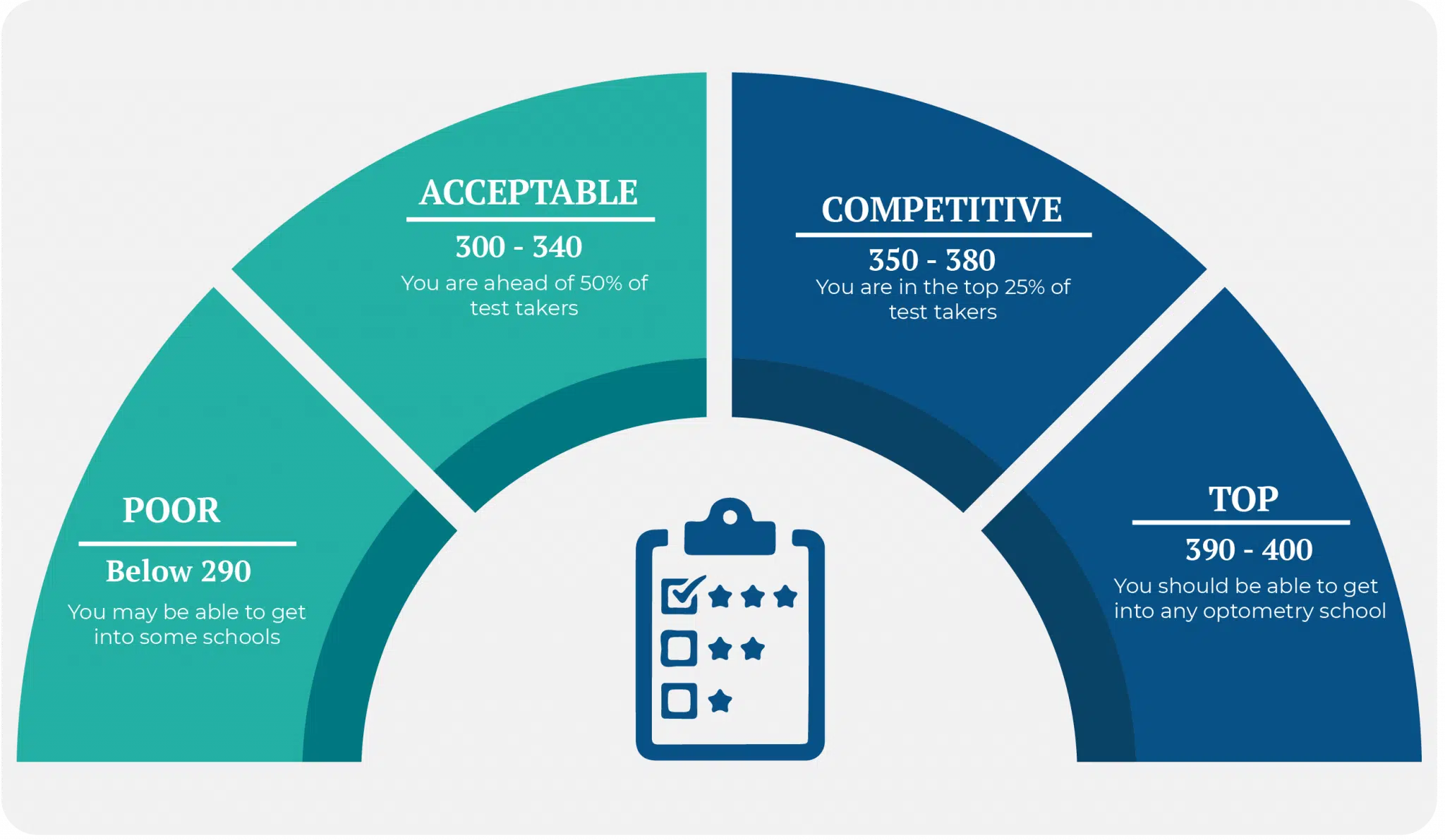
Approximated OAT Score, Based on Correct Answers per Section:
| OAT Score | Natural Science | Reading | Physics | Quantitative Reasoning |
|---|---|---|---|---|
| 380-400 | 85-100 | 45-50 | 35-40 | 32-40 |
| 360-380 | 80-85 | 40-45 | 32-35 | 30-32 |
| 340-360 | 70-80 | 35-45 | 30-32 | 26-30 |
| 320-340 | 60-70 | 25-35 | 25-30 | 23-26 |
| 300-320 | 50-60 | 20-25 | 22-25 | 20-23 |
| 280-300 | 40-50 | 15-20 | 18-22 | 16-20 |
| 250-280 | 30-40 | 8-15 | 15-18 | 12-16 |
| 200-250 | 0-30 | 0-8 | 0-15 | 0-12 |
Results Availability
An unofficial score report is provided at the test center immediately after completing the test. Official reports are sent to optometry schools within 3-4 weeks of taking the test and are posted to your OAT user account.
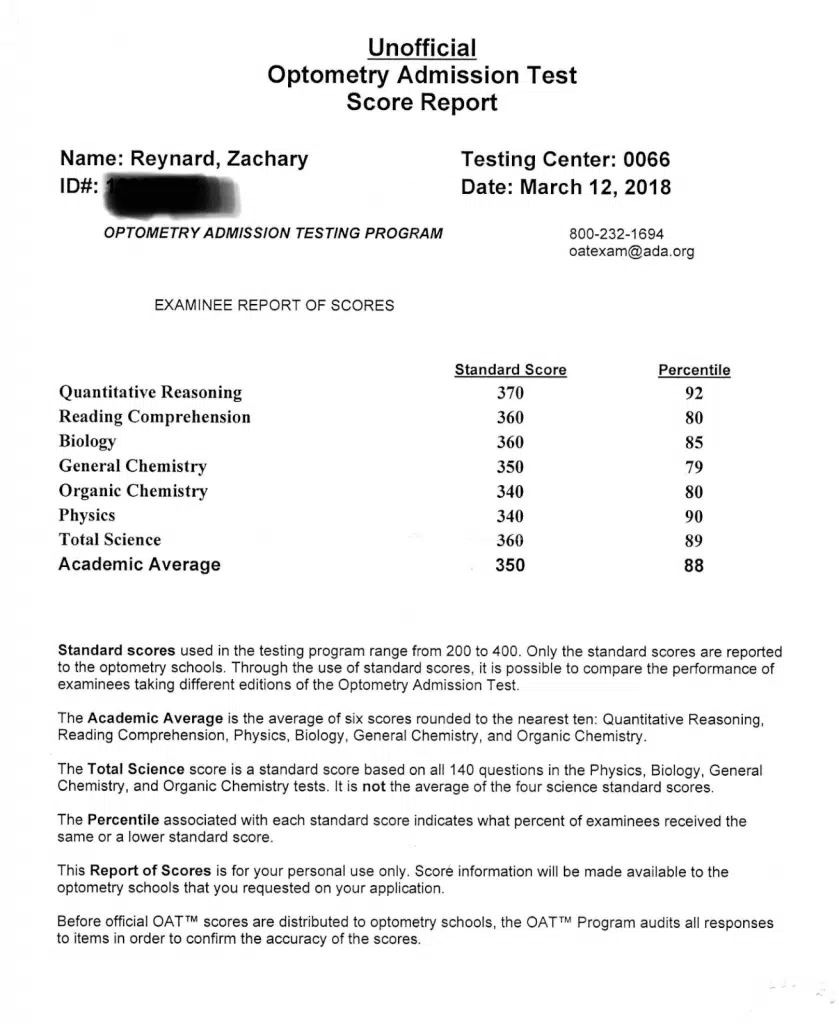
Interpretation of your score
| Performance | OAT Score | Interpretation |
|---|---|---|
| Top OAT Scores | 390-400 | You should be able to get into any optometry school |
| Competitive OAT Scores | 350-380 | You are in the top 25% of test takers and should make you highly competitive |
| Acceptable OAT Scores | 300-340 | You are ahead of 50% of test takers, but you may not have high enough scores to get into top schools |
| Poor scores | Below 290 | You may be able to get into some optometry schools |
OAT FAQs
The OAT exam is a test used to measure if a candidate to an optometry school is likely to succeed.
The OAT test challenges you with multiple-choice questions covering biology, general chemistry, organic chemistry, physics, reading comprehension, and math.
The OAT isn’t a pass/fail test, so there is no passing score. Candidates who score higher than 300 are in the top 50% of test takers and have a better chance of being accepted into an optometry program.
There are 230 questions on the OAT, divided into four sections.
You can retake the test after 90 days. If you would like to take the test for the third time, you must wait 12 months. Additional retakes require permission from the school to which you are applying to.
The OAT includes everything from simple arithmetic to advanced trigonometric problems.
During certain parts of the test, such as the quantitative reasoning section there will be a calculator on the screen that you can use. You may not bring your own calculator to the test.
The OAT is a challenging test covering physics, biology, and two types of chemistry with a limited time. However, the test doesn’t try to trick you. If you study and prepare, you should do well on the test.
In the MCAT, you need to read through complicated questions, which can be difficult. With the OAT, the test asks a question and you answer it.
The test itself takes four hours and five minutes. There is also an optional 15-minute tutorial at the beginning of the test, an optional half-hour break in the middle of the test, and an optional 15-minute survey at the end of the test. If you include all the optional portions of the test, it takes five hours and five minutes.
The OAT test is taken on a computer at a Prometric testing center.
There are lots of places where you can take an OAT practice test, including iPrep. Our practice tests and courses will prepare you for test day.
The basic test costs $490.
If your goal is to have your choice of schools, you will want to score a 350 or higher. If you would like a score that is good enough to get accepted into an optometry program, you will want to score at least a 300.
Most students prefer to take the OAT after they have completed their optometry school prerequisite classes, in the summer between junior and senior year. However, some students take the test before their junior year, so that if they do poorly they will have a second chance to take the test again.
OAT Test Tips
- Find the easy questions
Unlike other tests, the OAT questions are not presented from easiest to hardest. You are just as likely to find an easy question towards the end of the section as at the beginning. If you find yourself working on questions that are difficult, move along to the next question, which might be easier. Remember, easy questions are worth as many points as difficult questions.
- Find your favorite sections
If your strength is organic chemistry, skip ahead to that section on the test and do them first. There’s no need to answer questions in order. Just don’t forget to go back and get to the questions you may have missed.
- Eliminate obvious wrong answers
There is more than one way to figure out the right answer. Sometimes, you just have to eliminate answers that are obviously wrong. Eliminate a few answers, and you’ll improve your odds if you have to guess on an answer.
- Track your time
Be aware of how much time you have, and how much time you expect certain sections to take. Don’t waste time by focusing your energy on questions that will take too long to answer until you’ve gone through the test and answered the questions in the subjects in which you are strongest.
- Breathe
Stay calm, eat a healthy meal beforehand, and show up to the test mentally prepared. The test is long and can be grueling. Staying calm and coming in well-rested will help keep your brain clear and ready.
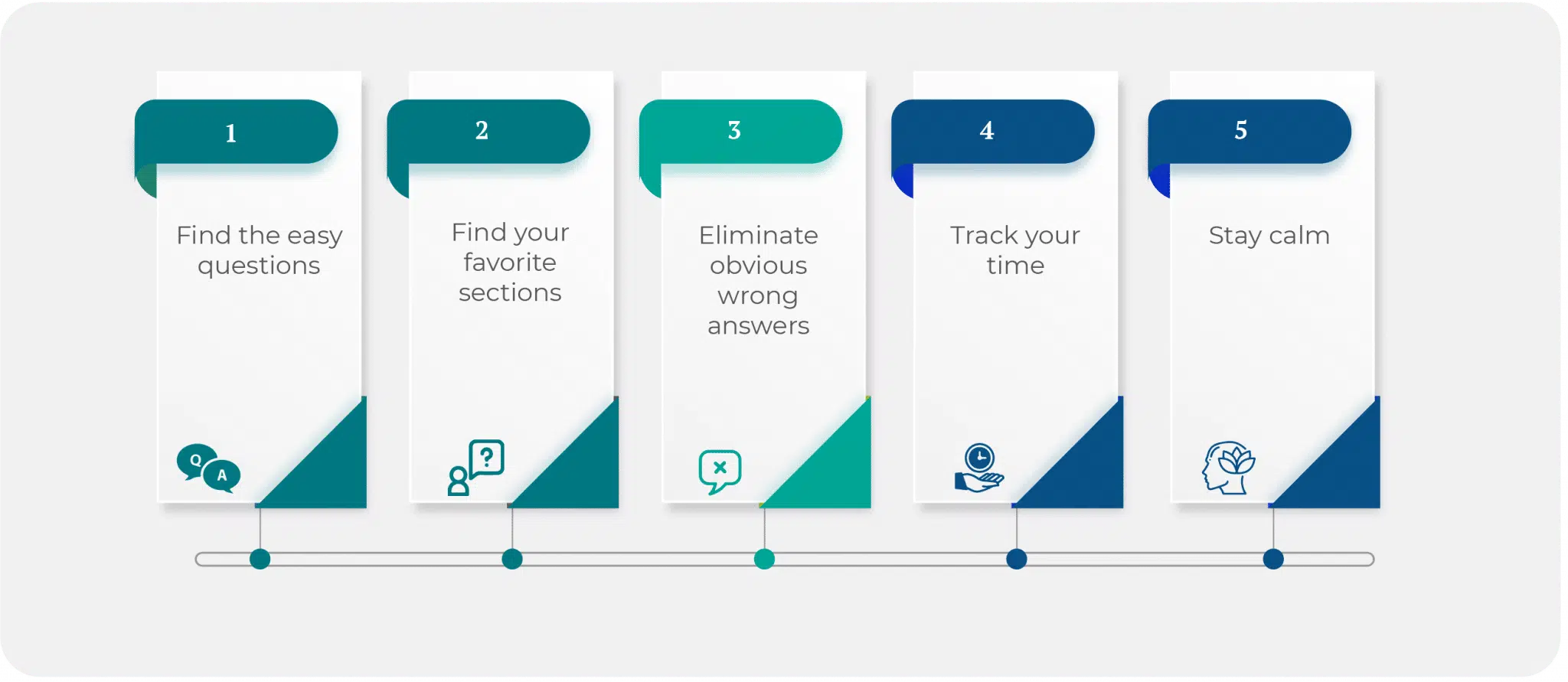
Administration
- Test Location: Tests are given at Prometric testing centers
- Test Schedule: You can take the test almost any time of year. However, you’ll want to schedule a date a few months in advance to get the date you want, especially in the busier summer season.
- Test Format: Multiple choice taken on computer.
- Test Materials: Taken on a computer with a calculator built into the platform. You will be provided with scratch paper.
- Cost: The fee for the basic test is $490.
- Retake Policy: You must wait 90 days to retake the test. To take the test a third time, you must wait 12 months.
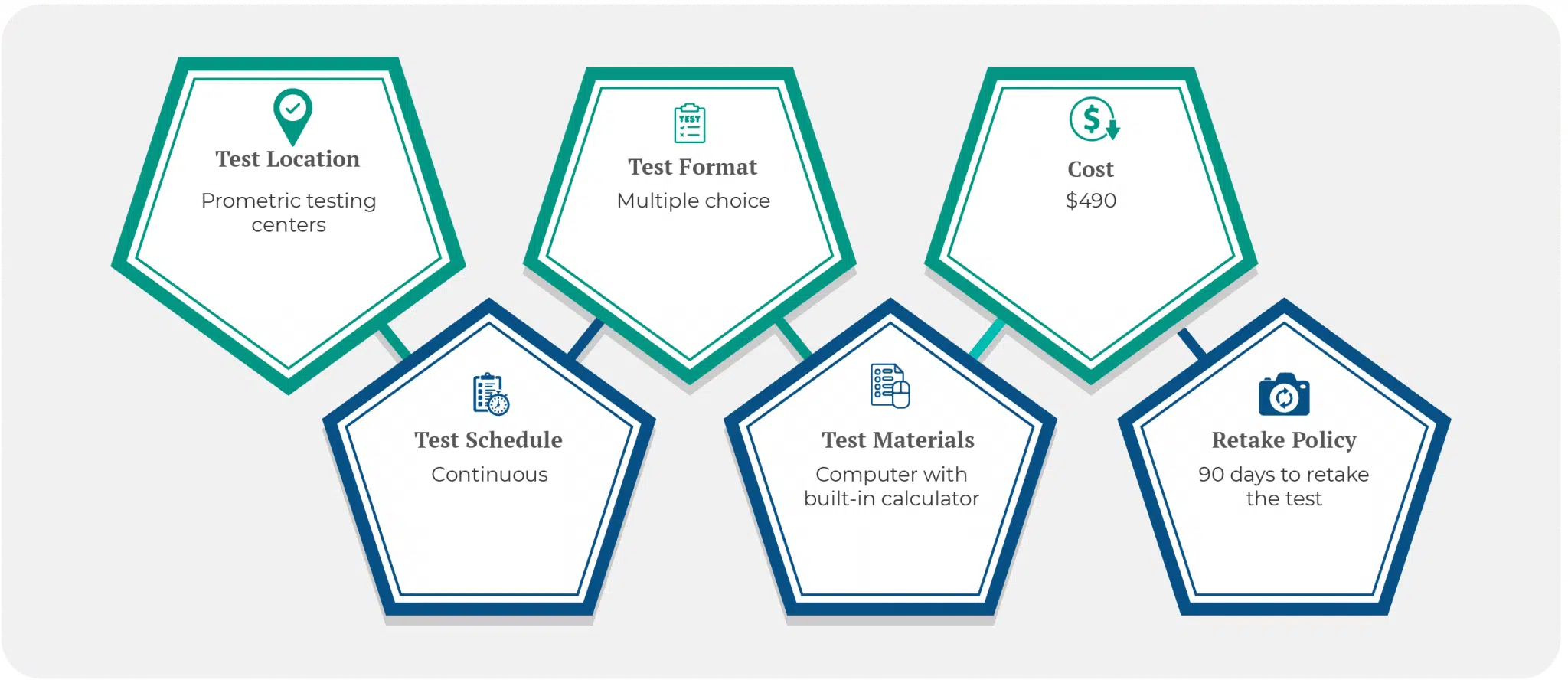
Test Provider
The OAT test is administered by the American Dental Association (ADA) on behalf of the Association of Schools and Colleges of Optometry (ASCO). The test is endorsed by the American Optometric Association (AOA). The test is administered by Prometric at their testing centers.
The test is designed to provide admissions offices with unbiased information regarding the likelihood of a candidate succeeding in an optometry program.
Information Sources
- ADA – American Dental Association
- ASCO – Association of Schools and Colleges of Optometry
- AOA – American Optometric Association
- Prometric
Disclaimer – All the information and prep materials on iPrep are genuine and were created for tutoring purposes. iPrep is not affiliated with the ADA, ASCO, AOA, Prometric testing centers, or any other company mentioned.
Free OAT practice test: Get to know what the Optometry Admission Test (OAT) will be like by practicing with these sample questions:
Question 1 of 8
Joules and calories are interconvertible units, 1 Calorie is equal to?
- 4200 J
- 2000 J
- 2 J
- 4.184 kJ
- 4000 J
The correct answer is D. 4.184 kJ
Explanation:
1 Cal= 1 kcal =1000cal
1 Cal = 4184 J = 4.184 kJ
Question 2 of 8
Elements in group I of the periodic table are known as:
- Alkali metals
- Halogens
- Alkaline earth metals
- Noble gases
- Transition elements
The correct answer is A: Alkali metals
Group, I elements are known as alkali metals, they form ionic compounds and when they react with water they form hydroxide.
Question 3 of 8
Boron has 2 isotopes B-10 which has 20% abundance and B-11 which has 80% abundance. Its relative atomic mass is:
- 100
- 60
- 50.5
- 5.8
- 10.8
The correct answer is E: 10.8
Relative atomic mass= (20×10) + (11×80) /100
Relative atomic mass = 200 + 880 /100
Relative atomic mass = 1080/100
Relative atomic mass = 10.8
Question 4 of 8
Audible sound has a frequency between:
- 450Hz-720 kHz
- 20 Hz -20 kHz
- 45 Hz -72 k Hz
- 20,000-25000 Hz
- Below 20 Hz
The correct answer is: B. 20 Hz – 20 kHz
Explanation: Audible sound waves, which a person can hear, have a frequency between 20 Hz to 20 kHz.
Question 5 of 8
Elements that have loose electrons available for the flow of electricity are known as:
- Diodes
- Insulators
- Noble gases
- Conductors
- Radioactive metals
The correct answer is: D. Conductors
Explanation: Conductors are substances through which an electric current can flow. Free electrons are required for the flow of electric current. Metals are good conductors of electricity.
Question 6 of 8
Evaluate the value of the unknown variable in the equation:
1/L = 13/8 + K/6
If L = 12,
K = __?__
- $$$ -9\dfrac{1}{4} $$$
- $$$ -9\dfrac{1}{2} $$$
- $$$ -9\dfrac{1}{6} $$$
- $$$ -9\dfrac{1}{24} $$$
The correct answer is A. (-9¼).
| 1/L = 13/8 + K/6 | (Substitute value of ‘L’ from the question). |
| 1/12 = 13/8 + K/6 | (Multiply LCD = 24 with the entire equation) |
| 24 * 1/12 = 24 * (13/8) + 24*(K/6) | (24/12 = 2; 24/8 = 3; 24/6 = 4) |
| 2 * 1 = 3 * 13 + 4 * K | |
| 2 = 39 + 4K | (Subtract ‘39’ from both sides of the equation). |
| 2 – 39 = 39 + 4K – 39 | |
| -37 = 4K | (Divide both sides of the equation by ‘4’). |
| (-37)/4 = K | (Convert improper fraction into a mixed fraction). |
| -(36 + 1)/4 = K | |
| -36/4 – 1/4 = K | |
| -9 – 1/4 = K | |
| K = -9¼ |
Question 7 of 8
Consider the following formula:
A = B +3 (C – 3)
If A = 10 and B = 1, what is the value of C?
- 3
- 9
- 4
- 6
The correct answer is 6.
In order to solve this question correctly, you need to remember the order of operations (PEMDAS):
- Parentheses
- Exponents
- Multiplication/Division
- Addition/Subtraction
In addition, you should remember that if you see a number which is written to the left of the parentheses with no sign between the number and the left bracket, then this number is a factor of the parentheses, which means it multiplies everything within the parentheses.
In order to find a solution, we need to isolate C.
First step – placing the values of A and B:
A = B +3(C – 3) Remember A = 10; B = 1
10 = 1 + 3(C – 3)
Second step – removing the parentheses:
10 = 1 + 3(C – 3) 3 is a factor of both C and -3
10 = 1 + 3C – 3*3 Simplify and collect like terms
10 = 3C + 1 – 9
Third step – isolating C and finding the solution:
10 = 3C – 8 Adding 8 to both sides
10 + 8 = 3C
18 = 3C Divide by 3
6 = C
Question 8 of 8
The new lottery scratch card series guarantees a 1/10 chance of winning some monetary prize and a 1/2 chance that the win will be a substantial sum. If I buy 20 lottery scratch cards from the new series, how many substantial wins should I expect?
- 10
- 2
- 1
- 4
- 0
The correct answer 1 substantial win.
Explanation:
You can either accumulate the chances in order to find the answer or to calculate the chance of winning a substantial sum in advance.
Step by step:
Tickets bought = 20
Chance of winning tickets = 20 * 1/10 = 20/10 = 2
Chance of a substantial win = 2 * 1/2 = 2/2 = 1
In advance:
Chance of a substantial win = 1/10 * 1/2 = 1/20
Of the tickets bought = 20 * 1/20 = 20/20 = 1
Tips for a quick solution:
- Problems that deal with proportions, combinations, and probabilities, usually appear towards the end of the test. If this is your mathematical strong suit, and time is about to run out, you can guess the answers and move closer to the end of the test.
- Remember that the probability of two terms happening together is always lower than the probability of each of them happening without the requirement of co-occurrence.
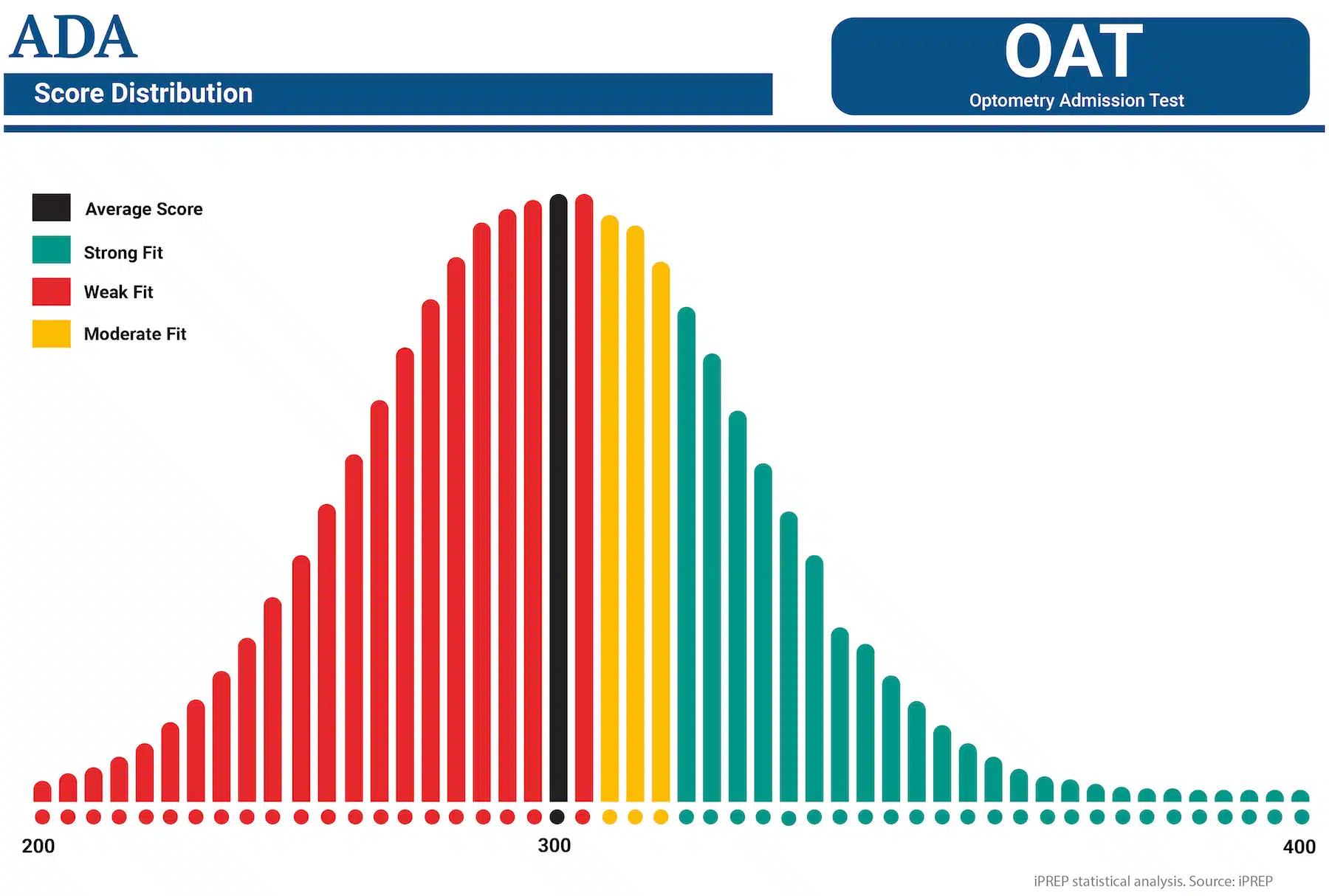
Well done!
You have completed the Sample Questions section.
The complete iPREP course includes full test simulations with detailed explanations and study guides.
‘…TESTS THAT ACTUALLY HELP’

In the first 30 minutes of use I have learned so much more than skipping along the internet looking for free content. Don’t waste you time, pay and get tests that actually help.
Richard Rodgers
January 28, 2020 at 7:49 PM
About the course
Welcome to iPrep’s OAT (Optometry Admission Test) preparation course.
This comprehensive course is designed to enhance your skills and boost your confidence as you prepare for the OAT exam, a crucial step towards acceptance into optometry schools. Here’s what our course offers:
Familiarization with Test Questions
You will become well-acquainted with the various types of questions on the OAT, gaining insights into their format and structure.
Practice with Realistic Questions
Each section includes questions that mirror those on the actual test, matching the same level of difficulty to provide you with an authentic practice experience.
Effective Tips and Strategies
Receive a wealth of helpful tips tailored to different question types. These tips are integrated within the introductory sections and detailed explanations that follow each question, ensuring you know how to approach and solve them efficiently.Knowledge and Comfort
By the end of this course, you’ll be more knowledgeable and comfortable with the OAT test. Familiarity with the test format and question types is essential for maximizing your score and improving your chances of success.
20
Learning hours
40
Practice tests
800
Questions
30
Day access
Course Structure
The course comprises both practice and learning sessions, guiding you through essential information and techniques necessary for success on the OAT. Our structured lessons will help you grasp the underlying principles of each test section.
Wishing you an enjoyable and productive learning experience!
Skills you will learn
Critical Reading
Quantitative Reasoning
Scientific Knowledge
Curriculum
- Course Introduction
- Question Types Introduction
- Reading Comprehension
- Quantitative Reasoning
- Natural Sciences & Physics (excluding organic chemistry)
- Course Conclusion
Customer testimonial

So far this is amazing course! I started it yesterday and it’s helping me a lot. Praying I’ll pass I wish more people had access to course like this.
Sajeeda Braxton
May 25, 2022 at 10:26 AM
Reviews

Jamilie A*****
April 15, 2024 at 7:34 PM
iPREP is a fantastic learning experience. Helped my study efforts substantially. I recommend to anyone who is studying for higher education.

Kelli M
January 18, 2024 at 9:28 PM
I think the iPrep access course is well prepared and section accurately. Maybe add a couple additional math practice test questions and actually OAT test questions as well.

Gabriel U*****
August 7, 2023 at 6:37 PM
I love how easy it is to navigate through the material. It allows for you to complete the prep your way, and gives you chances to try again.

Gabriel Ugarte
July 23, 2023 at 4:40 PM
I really enjoy this! The course is easy to navigate, it allows for you to review what you got right and wrong, and it is done at a good pace. Only gripe is to increase how long you can access it for.

Gabriel Ugarte
July 16, 2023 at 11:37 PM
I love this prep! Really easy to navigate, and it feels engaging. Really wish it lasted longer. Other than that, really recommend it to anyone who is prepping for the OAT.

Mahogany J*****
July 14, 2023 at 6:47 PM
I am so very happy I came across this website! Never even knew existed. Google searched ways to study for the OAT and this website popped up and I am glad I clicked the link! Thank you!

Gabriel Ugarte
July 12, 2023 at 7:16 PM
So far, I'm enjoying this course. It's engaging, and it tells me where I need improving. Really recommend it to anybody!

Gabriel Ugarte
July 7, 2023 at 6:22 PM
Love the content. Very detailed, and gives plenty of opportunities to try and get a better score. Only wish it lasted for more time.

Gabriel Ugarte
July 3, 2023 at 2:53 AM
Going through the course, I really liked that they had the explanations for the different sections, and how easy it was to follow through.

Victor O******
May 25, 2023 at 9:14 AM
I recommend iPrep for anyone struggling with understanding OAT tactics, this has been a great help for me to prepare for my OAT exam, easy to assimilate and understand
